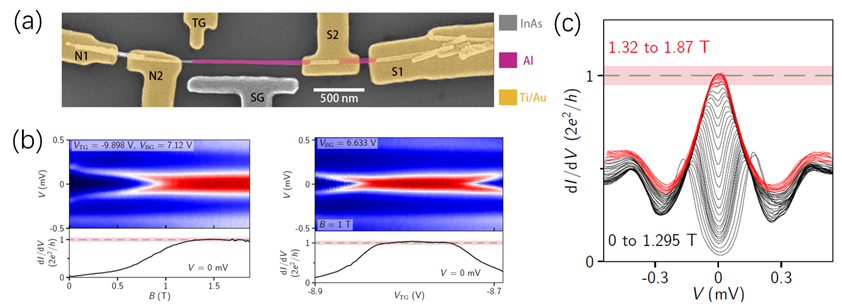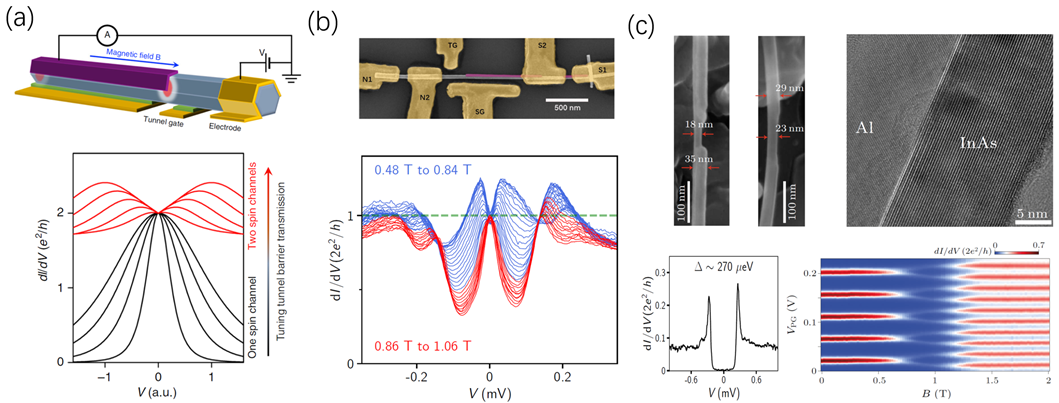Progress on quantized conductance for zero bias peaks in Majorana nanowires
2022/10/17
A semiconductor nanowire coupled to a superconductor could host Majorana zero modes. Therefore, these hybrid nanowires are often dubbed "Majorana nanowires" in literature. One major prediction of Majorana theory is a quantized zero-bias peak (ZBP) in tunneling conductance. Until recently, this signature was believed to be the"smoking gun" evidence of Majoranas. Theory developments in recent years have proposed an alternative mechanism based on Andreev bound states. This state, which can be decomposed into two Majoranas, could also lead to quantized ZBPs if the tunnel barrier region meets certain requirements. The quantization mechanism for the two cases are similar: the zero-bias conductance is solely contributed by one Majorana while the second Majorana is decoupled. Since this alternative state could mimic true Majoranas in transport or even braiding experiments, it is often dubbed "quasi-Majoranas" in literature.
Recently, the Topological Quantum Computation Group of BAQIS, in collaboration with the researchers of Tsinghua University and Institute of Semiconductor, Chinese Academy of Sciences, has significantly improved the InAs-Al nanowire device quality, and observes ZBPs quantized at 2e2/h with 5% tolerance (see the figure below). Sweeping three experimental parameters (magnetic field and two gate voltages) can all resolve a plateau near the quantized value. The observation is consistent with Majoranas or quasi-Majoranas. They publish their work entitled "Plateau regions for zero-bias peaks within 5% of the quantized conductance value 2e2/h" in Physical Review Letters.

(a) Device SEM. (b) ZBPs in magnetic field and gate scans. Lower, zero-bias line cuts. (c) Waterfall plot of a ZBP in a magnetic field scan.
Further lowering the tunnel barrier can push the conductance at finite bias above 2e2/h, but the zero-bias conductance could still maintain near the quantized value due to the spin selection of Majorana or quasi-Majorana. This will reveal a quantized zero-bias peak-to-dip transition when tuning the barrier transmission, presumably using a gate near the tunnel barrier. See the figure below (panel a) a sketch for the transition, image taken from Nature Communications 10, 5128 (2019). In a separate work, the team observes a magnetic-field-driven zero-bias peak-to-dip transition near 2e2/h (see panel (b)). They publish their work entitled “Large zero bias peaks and dips in a four-terminal thin InAs-Al nanowire device” in Physical Review Research. The two works above are based on ultrathin InAs-Al hybrid nanowires. The thinness of InAs diameter is aiming for reaching single subband regime. These hybrid nanowires were grown by the team of Prof. Jianhua Zhao in Institute of Semiconductors, Chinese Academy of Sciences. Zhang group calibrated the hard superconducting proximity gap and 2e-Cooper-pair Coulomb blockade (see panel (c)). This work, entitled “In situ epitaxy of pure phase ultra-thin InAs-Al nanowires for quantum devices”, is published in Chinese Physics Letters.

(a) Schematic of a Majroana device (upper) and quantized peak-to-dip transition (lower). (b) Device SEM (upper) and magnetic-field-driven peak-to-dip transition near 2e2/h. (c) SEM and TEM of ultrathin InAs-Al nanowires (upper) and hard superconducting gap and 2e Coulomb blockade (lower).
These works are supported by National Natural Science Foundation of China, Beijing Natural Science Foundation and Alibaba Innovative Research Program. Tsinghua University Initiative Scientific Research Program, Frontier Science Center for Quantum Information.
Paper links:
https://link.aps.org/doi/10.1103/PhysRevLett.129.167702
https://link.aps.org/doi/10.1103/PhysRevResearch.4.033235
http://cpl.iphy.ac.cn/Y2022/V39/I5/058101
 中文
中文 Email
Email QCloud
QCloud Log in
Log in
